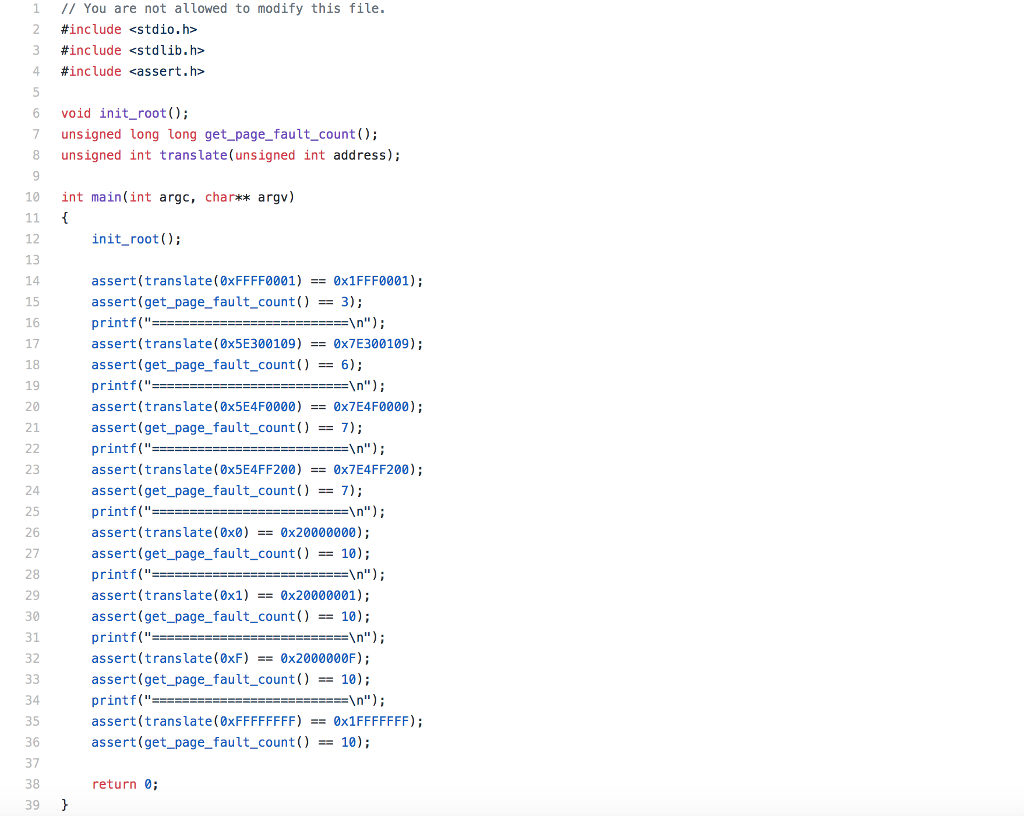Question
Implement a MMU simulator to help us better understand virtual memory management. Please read mmu_lib.c and mmu.c . Before diving into the code, read the
Implement a MMU simulator to help us better understand virtual memory management. Please read mmu_lib.c and mmu.c. Before diving into the code, read the comments in mmu_lib.c first. After understanding the code, fix the FIXMEs in mmu_lib.c.
sorry it long please help!
mmu.c

mmu_lib.c
| #include | |||||||
| #include | |||||||
| // This file implements a naive 32-bits memory management unit(MMU) simulator | |||||||
| // to do virtual memory control. | |||||||
| // | |||||||
| // NOTE1: The number of bits of virtual (offset) for each layer may be different | |||||||
| // from the real Intel CPU. We are creating our own MMU. | |||||||
| // | |||||||
| // NOTE2: Please treat all unsigned long long as 4 bytes here because we are using | |||||||
| // a 64-bit program to simulate a 32-bit MMU. | |||||||
| // | |||||||
| // APIs: | |||||||
| // init_root(): Initialize the L0 page table (root page table). In modern | |||||||
| // OS, a similar API is called in the early stage of the | |||||||
| // booting process of the OS. | |||||||
| // | |||||||
| // page_fault_get_physical_page(address): Gets a physical memory page. | |||||||
| // | |||||||
| // translate(address): Translates a virtual address to the corresponding | |||||||
| // physical address. | |||||||
| // | |||||||
| // | |||||||
| // | |||||||
| #define BITS_IN_L0 (3) | |||||||
| #define ENTRIES_IN_L0 (1 | |||||||
| #define BITS_IN_L1 (4) | |||||||
| #define ENTRIES_IN_L1 (1 | |||||||
| #define BITS_IN_L2 (5) | |||||||
| #define ENTRIES_IN_L2 (1 | |||||||
| #define BITS_IN_OFFSETS (20) | |||||||
| unsigned long long root_page_table[ENTRIES_IN_L0]; | |||||||
| unsigned long long page_fault_count = 0; | |||||||
| void init_root() | |||||||
| { | |||||||
| for (int i = 0; i | |||||||
| root_page_table[i] = 0; | |||||||
| } | |||||||
| } | |||||||
| // NOTE: You don't need to understand how this API generates a physical memory | |||||||
| // page (because it's fake). But you need to understand why we need this | |||||||
| // API. | |||||||
| unsigned int page_fault_get_physical_page(unsigned int address) | |||||||
| { | |||||||
| unsigned long long addr = address; | |||||||
| return (unsigned int)((((addr >> BITS_IN_OFFSETS) | |||||||
| } | |||||||
| unsigned int translate(unsigned int address) | |||||||
| { | |||||||
| unsigned long long* l1_page_table; | |||||||
| unsigned long long* l2_page_table; | |||||||
| // Layer 0, root | |||||||
| int index_in_l0 = address >> (32 - BITS_IN_L0); | |||||||
| printf("Index in L0(root) page table : %X ", index_in_l0); | |||||||
| if (root_page_table[index_in_l0] == 0) { | |||||||
| // page fault | |||||||
| printf("L0 page fault "); | |||||||
| page_fault_count += 1; | |||||||
| root_page_table[index_in_l0] = (unsigned long long)malloc(sizeof(unsigned long long) * ENTRIES_IN_L1); | |||||||
| l1_page_table = (unsigned long long*)root_page_table[index_in_l0]; | |||||||
| for (int i = 0; i | |||||||
| l1_page_table[i] = 0; | |||||||
| } | |||||||
| } else { | |||||||
| l1_page_table = (unsigned long long*)root_page_table[index_in_l0]; | |||||||
| } | |||||||
| // Layer 1 | |||||||
| // FIXME: index_in_l1 is incorrect. | |||||||
| int index_in_l1 = (address > (32 - BITS_IN_L1); // I tried to do this but I don't know if it is right | |||||||
| printf("Index in L1 page table : %X ", index_in_l1); | |||||||
| if (l1_page_table[index_in_l1] == 0) { | |||||||
| // page fault | |||||||
| page_fault_count += 1; | |||||||
| printf("L1 page fault "); | |||||||
| // FIXME: Constructs the missing L2 page table (yes, it's L2 not L1). I tried this too but not sure what to do..
| |||||||
| } else { | |||||||
| // FIXME: Gets the existing L2 page table (yes, it's L2 not L1). l2_page_table = (unsigned long long*)root_page_table[index_in_l1]; | |||||||
| } | |||||||
| // Layer 2 | |||||||
| int index_in_l2 = (address > (32 - BITS_IN_L2); | |||||||
| printf("Index in L2 page table : %X ", index_in_l2); | |||||||
| if (l2_page_table[index_in_l2] == 0) { | |||||||
| printf("L2 page fault "); | |||||||
| // page fault | |||||||
| page_fault_count += 1; | |||||||
| l2_page_table[index_in_l2] = page_fault_get_physical_page(address); | |||||||
| } | |||||||
| // FIXME: page_offset is incorrect. | |||||||
| int page_offset = 0; | |||||||
| printf("Page offset : %X ", page_offset); | |||||||
| // FIXME: return value is incorrect; | |||||||
| return 0; | |||||||
| } | |||||||
| unsigned long long get_page_fault_count() | |||||||
| { | |||||||
| return page_fault_count; | |||||||
| } |
Step by Step Solution
There are 3 Steps involved in it
Step: 1

Get Instant Access to Expert-Tailored Solutions
See step-by-step solutions with expert insights and AI powered tools for academic success
Step: 2

Step: 3

Ace Your Homework with AI
Get the answers you need in no time with our AI-driven, step-by-step assistance
Get Started


